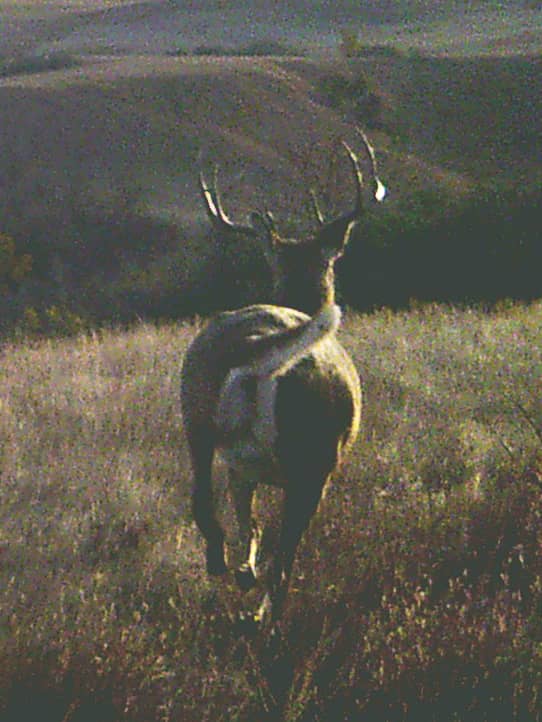
Up and Outta Here. A fleeing buck raises the white flag and takes to the hoof after being startled. Simonson Photo.
By Nick Simonson
From across a golden field of fall CRP grasses, or bounding through the leafless November brush on a steep hillside, it’s easy to see the arching back-and-forth following a whitetail deer in full flight. Their name says it all and that white flag on their rear end typically does too. From the gentle flick signaling that everything is cool, to that wild waving that lets every other deer in the herd know it’s time to get out of Dodge, a deer’s tail is a signal to both hunters and other deer about what’s going on in the world and how they’re feeling at a given moment.
With enough time on stand picking up on those context clues as to what a deer is about to do next will help with future hunts. Their tails say a lot about what they think they know regarding any situation and potentially your presence in their world, and ultimately when you’ve been busted, or when they’ve been bumped and taken to the hoof. Knowing what the varied states of a whitetail’s tail mean is an important tool in any hunt and can give you a final warning as to when your last shooting opportunity may occur as a deer closes the distance.
Flicking Fine
The gentle flick of a whitetailed deer’s tail as it browses, travels, or simply assesses the situation is always a good sign for hunters. It means the deer is unaware of your presence and is going about its daily activities without reason for alarm. Watch for a pause in between flicks, and then for it to resume, along with an occasional head raise to chew, take a look around, and then dip back down to the ground to nibble grasses or slowly move along. Typically, with a flicking tail the deer’s body is loose, and its gait is slow and reserved, moving at a normal walk or in the process of feeding.
Half Mast
If a deer begins to raise its tail, holds it out or up just slightly, or the cadence of flicking suddenly stops, there’s something going on that a whitetailed deer doesn’t like. I’ve seen it when cars or farm trucks pass by on a gravel road on a calm morning or evening, or something else is moving around in the trees around me while on stand. A slightly lifted tail that is rigid and no longer in motion is a signal that the deer knows something is up. Accompanied by a raised nose, or a snort along with a tightened body or a foot stomp, a half-raised tail could also mean they caught that slight shift you made on stand or perhaps found your scent line in a slight breeze and your time to take the shot is limited.
On Alert
The final phase of the deer’s natural alarm system is a raised or waving tail. If the tail on a whitetailed deer goes up while the animal is near you or in front of your stand, you’ve been made. After any series of snorts, wheezes, or foot stomps, it’s likely that tail is straight up and you’re about to see that hard turn that starts off the animal’s emergency sprint out of an area it perceives as dangerous. From there, you – and every other deer in the area – will observe the evolved alarm signaling others to rely on their flight instincts and exit the space immediately. A bounding deer that leaves your hunting area, or suddenly appears at a run with tail up and waving, is in a very startled state, and often does not slow down. If in the latter situation a buck does appear at full speed with tail up, you can attempt a grunt or a bleat to catch his attention, but depending on how long he’s been running, and what he’s interested in doing, it may not stop his sprint.
There are other in-between signals a deer’s tail can give off. I’ve seen agitated does tense their tails before engaging in hoof battles and certainly watched similar cues from rutting bucks as they were about to lock horns. Keeping an eye on the language of a deer’s tail and learning as much of it as you can will help you know when you have a shot at filling your tag, what deer are feeling in the moment, and when the hunt is about to change…in our outdoors.
